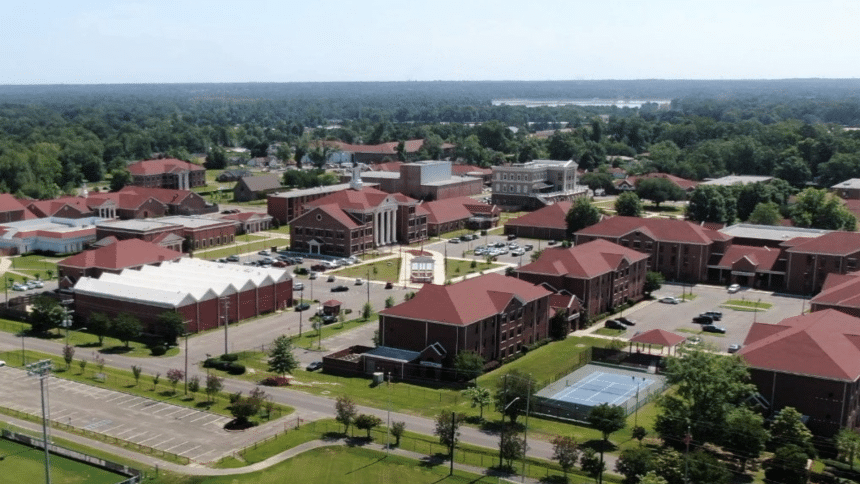In a world of nosediving student enrollment for colleges and universities across the U.S. and increasingly stingy competition among peers, William Carey University is thriving.
The National Center for Education Statistics says enrollment nationwide has dropped more than 15% in the last decade, a number that sunk 5% more from the 2022-23 to 2023-24 school year. The climb for private institutions is even steeper, with less than 30% of American undergraduates now attending non-public schools.

But in that same 10-year stretch, Carey has defiantly marched in the opposite direction. It began with a renewed objective of expansion under the late Dr. Tommy King in post-Katrina south Mississippi. It hit warp speed in the wake of the 2017 tornado that decimated the Hattiesburg campus, sparking a recovery that turned to transformation.
Dr. Ben Burnett has held the reigns as president since King’s retirement in 2022. As he put it following his inauguration, Burnett isn’t filling King’s shoes but “standing on the shoulders of a giant.”
Since 2015, William Carey has poured more than $175 million into construction, capital improvements, and a slew of other projects at both its home base in Hattiesburg and its newer Tradition campus in Biloxi.
Accolades, attention, and enrollment have all followed suit.
William Carey was recently ranked by Niche as Mississippi’s top private university, best small college, best Christian college, best college for education, and safest college campus. WCU was also ranked the No. 11 Best College for Education in the entire U.S. among 957 schools that offer education degrees, and the No. 10 Best Christian College in America.
Most other universities – both public and private – are standing on tenuous footing. But Dr. Burnett says Carey’s success is a credit to the school’s commitment to culture, community, and its founding mission. Because of that trio of factors, the experience is different.
“We know our students,” Dr. Burnett told SuperTalk Mississippi News, noting that WCU has retained a small campus feel even as it’s grown to more than 5,000 students. “I think that makes it meaningful to our students and makes our faculty and staff contribute and want to stay here longer.”
Retention isn’t the only number that’s up. The College of Osteopathic Medicine continues to balloon, more than doubling in size over the last 10 years and becoming the largest medical school in the state of Mississippi. And as of late, a previously stagnant undergraduate student body is growing again.
The largest freshman class in Carey history landed on campus to begin the 2024-25 academic year, with early projections hinting that 2026 could shatter that mark.
“We don’t think there is a ceiling,” Dr. Burnett said of Carey’s growth. “We’re not necessarily trying to become a 20,000-student population – although I think that’s possible. But maybe not during my tenure.”
As of now, school leaders have their sights set on the 8-10,000 student range. A recent purchase of 107 acres adjacent to the Hattiesburg campus and abundant expansion space on the Tradition campus means there’s more than enough room to grow.
But as enrollment blooms and the superlatives stack, the mission stays the same.
Dr. Burnett pointed to the school’s namesake, Dr. William Carey, as the cornerstone for what the school strives to be. A devotion to service colors the Crusader way, following in step with the legacy left by the “father of modern missions” nearly 200 years ago.
The medical school’s burgeoning reputation as a producer of rural practicians is reflective of that commitment. William Carey-trained doctors are steadily chipping away at Mississippi’s rural healthcare crisis, with nearly 500 physicians placed in rural health facilities since 2019.
“We’ve got a lot of high rankings and a lot of accolades, but our heart is to serve,” Burnett said. “And that’s more important than anything else we’re doing right now. It’s not just our namesake, it’s our mission.”
That mission is churning forth at a pace never seen before from William Carey, with no signs of the advancement slowing any time soon. A recent economic impact released by the university shows the effect isn’t isolated, with Carey’s progress supporting more than 1,200 jobs in Mississippi and generating $131 million for the state.
If the flight path stays true for south Mississippi’s oldest but fastest growing higher education institution, William Carey will soon rise to the ranks of a major player. At a press conference in late January, Dr. Burnett gave a succinct summation of the course Carey is now following:
“We are out of the shadows, and we are going big time.”







